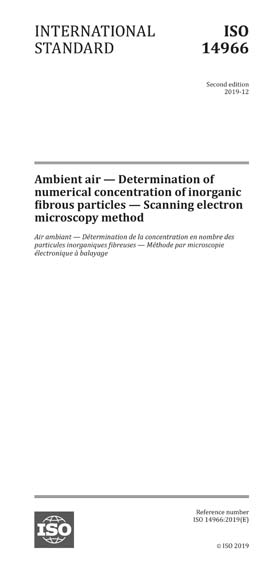Most recent
ISO 14966:2019
Ambient air - Determination of numerical concentration of inorganic fibrous particles - Scanning electron microscopy method
This document specifies a method using scanning electron microscopy for determination of the concentration of inorganic fibrous particles in the air. The method specifies the use of gold-coated, capillary-pore, track-etched membrane filters, through which a known volume of air has been drawn. Using energy-dispersive X-ray analysis, the method can discriminate between fibres with compositions consistent with those of the asbestos varieties (e.g. serpentine and amphibole), gypsum, and other inorganic fibres. Annex C provides a summary of fibre types which can be measured.
This document is applicable to the measurement of the concentrations of inorganic fibrous particles in ambient air. The method is also applicable for determining the numerical concentrations of inorganic fibrous particles in the interior atmospheres of buildings, for example to determine the concentration of airborne inorganic fibrous particles remaining after the removal of asbestos-containing products.
The range of concentrations for fibres with lengths greater than 5 µm, in the range of widths which can be detected under standard measurement conditions (see 7.2), is approximately 3 fibres to 200 fibres per square millimetre of filter area. The air concentrations, in fibres per cubic metre, represented by these values are a function of the volume of air sampled.
The ability of the method to detect and classify fibres with widths lower than 0,2 µm is limited. If airborne fibres in the atmosphere being sampled are predominantly <0,2 µm in width, a transmission electron microscopy method such as ISO 10312[8] can be used to determine the smaller fibres.
International Organization for Standardization [iso]

